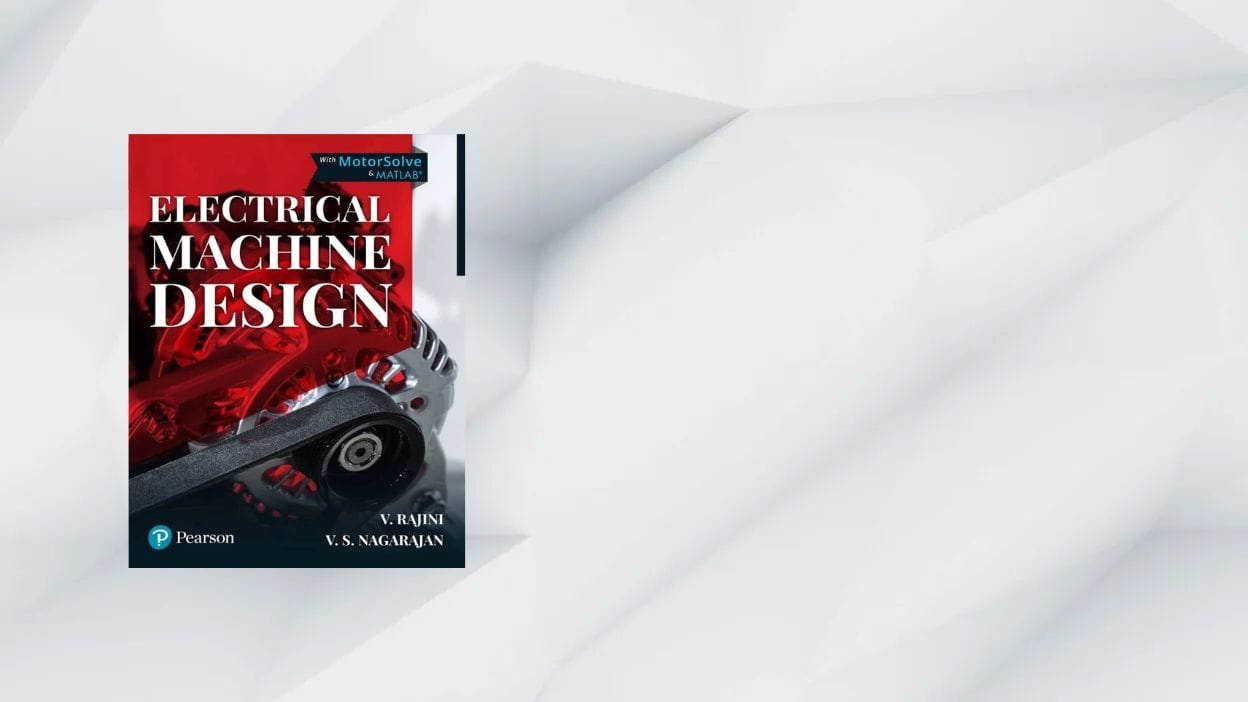Designing efficient, reliable electrical machines is at the heart of everything from EV traction motors to massive hydro generators. Electrical Machine Design by V. Rajini and V. S. Nagarajan (Pearson India, 2018) walks students and practicing engineers through the end-to-end process of sizing, selecting materials, and validating performance—complete with worked examples, objective questions, MATLAB/C code snippets, and finite-element simulation insights.
Book at a Glance
| Title | Electrical Machine Design |
| Authors | V. Rajini & V. S. Nagarajan |
| Publisher / Year | Pearson India Education Services • 2018 |
| Format / Length | Paperback & eBook • 648 pp. |
| ISBN-13 | 978-9332585577 |
| Typical Price | US $40–60 new; US $20–30 used |
| Audience | UG/PG electrical-machine students, R&D engineers, competitive-exam aspirants |
Why Electrical Machine Design Still Matters
- Comprehensive scope – Covers DC machines, induction motors, synchronous and PM machines, transformers and special machines, all in one volume
- Practice-oriented – Objective questions, review problems, and step-by-step numerical examples reinforce theoretical derivations.
- Simulation integration – MATLAB/C code listings and Finite Element Motor Solve simulations give hands-on exposure to CAD-style workflows.
- Competitive-exam prep – GATE- and UPSC-style MCQs and short-answer questions at the end of each chapter make it a dual-purpose textbook and revision guide.
Chapter Highlights
| Chapter | Content Focus | Key Take-Aways |
|---|---|---|
| 1. Basic Design Considerations | Constraints, specifications, output equations | Translate application specs into design targets |
| 2. Magnetic Circuit Design | Flux distribution, core losses, slot/pole geometry | Optimize core dimensions for efficiency |
| 3. DC Machine Design | Armature reaction, commutation, mechanical layout | Balance efficiency, torque ripple and manufacturability |
| 4. Induction Motor Design | Equivalent circuits, thermal limits, rotor configurations | Size air-gap, determine winding turns & gauge |
| 5. Synchronous Machine Design | Field winding, damper windings, regulation | Achieve target voltage and stability margins |
| 6. Special Machines | BLDC, stepper & switched-reluctance machines | Incorporate permanent magnet and reluctance principles |
| 7. Transformer Design | Core type, winding insulation & cooling | Ensure voltage regulation and overload resilience |
| 8. Simulation & CAD Tools | MATLAB code, FEA workflows | Validate analytical design with numerical models |
| 9. Test, Manufacturing & Standards | Performance tests, ISO/IEC guidelines | Prepare test reports and ensure compliance |
Key Strengths
- End-to-end design narrative – No black-box: each formula is derived, exemplified, and then implemented in code.
- Rich problem sets – Over 200 problems of varying difficulty, from plug-and-chug to mini-project topics.
- Industry relevance – Values and examples drawn from real-world motor catalogs and IEEE/IEC standards.
- Digital supplements – Accompanying e-resources include simulation files and C/MATLAB snippets.
Limitations
| Limitation | Impact | Work-around |
|---|---|---|
| 2018 component data | Material and conductor specs may lack newest grades (e.g., amorphous steel cores) | Update tables with vendor datasheets or recent literature |
| Limited thermal-fluid analysis | Cooling modes covered briefly; detailed CFD not included | Pair with a dedicated thermal-management text |
| No EV-specific case studies | Electric-vehicle motor topologies get only brief mention | Supplement with specialized EV motor design references |
How It Compares
| Feature | Electrical Machine Design (2018) | Design of Rotating Electrical Machines (Krause & Wasynczuk, 2013) | Electrical Machines (Pillay & Krishnan, 2002) |
|---|---|---|---|
| Pages | 648 | 880 | 672 |
| Simulation content | MATLAB/C + FEA | Simulink + manual FEA | SPICE-based examples |
| Problem sets | Robust, exam-style | Theory-focused | Balanced |
| Practical examples | Catalog-driven | Case studies of industrial drives | Academic motifs |
| Best for | Classroom & competitive-exam prep | Advanced R&D workflows | First-course UG textbooks |
FAQ
Is Electrical Machine Design suitable for beginners?
It assumes undergraduate-level circuit theory and basic magnetics; first-year students may prefer a simpler intro before tackling it.
Does the book include MATLAB code?
Yes—chapters 8 and appendices provide ready-to-run MATLAB and C programs, plus FEA model files for Motor Solve.
Can it help with GATE preparation?
Absolutely—the end-of-chapter objective questions and review problems are styled on GATE and UPSC exam formats.
Where can I buy it?
Available new from major online retailers and Pearson India’s site; used copies often sell for US $20–30 on Amazon/eBay.

